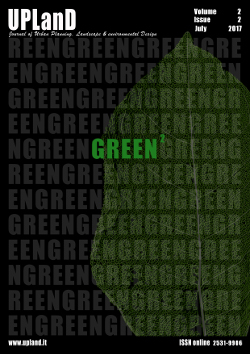The Living Archive and the Sublime Nature of the Anthropocene
Main Article Content
Abstract
At the 2015 UN Conference on Climate Change in Paris France, 195 nations reached a decision to commit to decrease the severe effects of climate change on the planet. As we embark what some call the Anthropocene Era, we bare witness to how civilization has impacted the Earth’s ecosystem, diminishing its resources and threatening its biodiversity. With this shift in our ecosystem, a new pedagogical model for a graduate architecture studio responded to the Anthropocene through a technologically sublime intervention: The Living Archive, a new architectural type capturing the magnitude of Earth’s inevitable transformation. This archive is conceived as the anti-thesis to sustainability and optimization that consumes much of our built world. The ‘living archive’ program is not meant to be a stable, secure vessel but uses technological invention to bracket what is being invaded by human existence. Through the invention of an ‘archiving machine’, the studio used technological speculation to question what nature can or will become. The aim was to use ‘living archive’ as a physical commentary or critique on our current relationship to the environment. The paper describes three projects that speculate on the inevitable future of various biomes. Through environmental analysis, technological research, and formal aspirations, each project embodies a potential reality and potential future of the Anthropocene.
Downloads
Download data is not yet available.
Article Details
How to Cite
LarsenJ. (2017). The Living Archive and the Sublime Nature of the Anthropocene. UPLanD - Journal of Urban Planning, Landscape & Environmental Design, 2(2), 223-238. https://doi.org/10.6093/2531-9906/5267
Issue
Section
Articles

This work is licensed under a Creative Commons Attribution-NonCommercial-NoDerivatives 4.0 International License.
Authors who publish with this journal agree to the following terms:- Authors retain copyright and grant the journal right of first publication with the work simultaneously licensed under a Creative Commons Attribution License that allows others to share the work with an acknowledgement of the work's authorship and initial publication in this journal.
- Authors are able to enter into separate, additional contractual arrangements for the non-exclusive distribution of the journal's published version of the work (e.g., post it to an institutional repository or publish it in a book), with an acknowledgement of its initial publication in this journal.
- Authors are permitted and encouraged to post their work online (e.g., in institutional repositories or on their website) prior to and during the submission process, as it can lead to productive exchanges, as well as earlier and greater citation of published work (See The Effect of Open Access).
References
Allen, S. (2012) "Infrastructural Urbanism." In Points and Lines: Diagrams and Projects for the City. New York: Princeton Architectural
Barber, D. (2016) "Architectural History in the Anthropocene." The Journal of Architecture 21, no. 8
Gissen, D. (2010) “APE” In Design ecologies: essays on the nature of design. New York.: Princeton Architectural Press
Hille, K. (2016) "Carbon Dioxide Fertilization Greening Earth, Study Finds." NASA. April 25. Accessed February 27, 2017. https://www.nasa.gov/feature/goddard/2016/carbon-dioxide-fertilization-greening-earth/.
McKie, R. (2017) "Could a £400bn plan to refreeze the Arctic before the ice melts really work?" The Observer. February 11, 2017. Accessed February 27, 2017. https://www.theguardian.com/world/2017/feb/12/plan-to-refreeze-arctic-before-ice-goes-for-good-climate-change.
Nye, D. (2007) American technological sublime. Cambridge, Mass.: MIT Press
Orlowski, J. (2012) Chasing Ice, a film that documents photographer James Balog and his extreme survey of arctic ice to publicize the effects of climate change. Moyers & Company: Chasing Ice. Accessed February 25, 2016. https://chasingice.com/.
Rönnskog, A. (2013) "Matters of Observation." In Architecture in the Anthropocene: encounters among design, deep time, science and philosophy. Ann Arbor: Open Humanities Press, an imprint of Michigan Publishing, University of Michigan Library.
Reinchholf, J. (2002) "Progress through Catastrophes: How Extinctions Further Evolution" In Cataloguing Life on Earth: Life Counts
United Nations Framework Convention on Climate Change. "Status of Ratification." The Paris Agreement - main page. February 01, 2017. Accessed May 26, 2017. http://unfccc.int/paris_agreement/items/9485.php
Barber, D. (2016) "Architectural History in the Anthropocene." The Journal of Architecture 21, no. 8
Gissen, D. (2010) “APE” In Design ecologies: essays on the nature of design. New York.: Princeton Architectural Press
Hille, K. (2016) "Carbon Dioxide Fertilization Greening Earth, Study Finds." NASA. April 25. Accessed February 27, 2017. https://www.nasa.gov/feature/goddard/2016/carbon-dioxide-fertilization-greening-earth/.
McKie, R. (2017) "Could a £400bn plan to refreeze the Arctic before the ice melts really work?" The Observer. February 11, 2017. Accessed February 27, 2017. https://www.theguardian.com/world/2017/feb/12/plan-to-refreeze-arctic-before-ice-goes-for-good-climate-change.
Nye, D. (2007) American technological sublime. Cambridge, Mass.: MIT Press
Orlowski, J. (2012) Chasing Ice, a film that documents photographer James Balog and his extreme survey of arctic ice to publicize the effects of climate change. Moyers & Company: Chasing Ice. Accessed February 25, 2016. https://chasingice.com/.
Rönnskog, A. (2013) "Matters of Observation." In Architecture in the Anthropocene: encounters among design, deep time, science and philosophy. Ann Arbor: Open Humanities Press, an imprint of Michigan Publishing, University of Michigan Library.
Reinchholf, J. (2002) "Progress through Catastrophes: How Extinctions Further Evolution" In Cataloguing Life on Earth: Life Counts
United Nations Framework Convention on Climate Change. "Status of Ratification." The Paris Agreement - main page. February 01, 2017. Accessed May 26, 2017. http://unfccc.int/paris_agreement/items/9485.php

